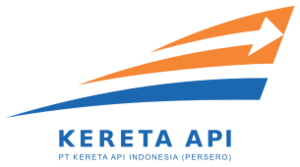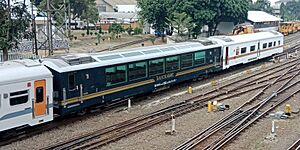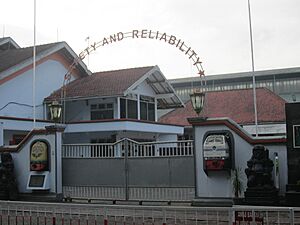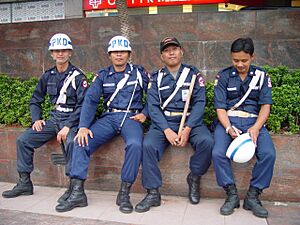Kereta Api Indonesia facts for kids

Logo used since 28 September 2020
|
|
|
Formerly
|
Indonesian State Railways (DKARI/DKA/PNKA/PJKA) (1945–1990) Indonesian Railway Public Corporation (Perumka) (1990–1995) |
|---|---|
| State-owned perseroan terbatas | |
| Traded as | IDX: KAII (bonds) |
| Headquarters |
,
Indonesia
|
|
Key people
|
Said Aqil Siradj (chairman of the advisory board) Didiek Hartantyo (CEO) |
| Revenue | |
| Total assets | |
| Owner | Government of Indonesia |
|
Number of employees
|
27,396 (2017) |
| Subsidiaries | KAI Commuter KAI Bandara KAI Logistik KAI Wisata KAI Properti KAI Services |
 |
|

Map of active railway lines in Java as of 2019
|
|
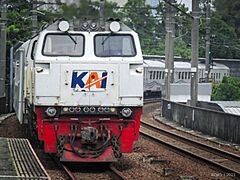 |
|
| Overview | |
|---|---|
| Fleet size |
List
420 locomotives
578 electric multiple units (by KCI) 121 diesel multiple units 1,607 passenger coaches 6,782 freight cars |
| Headquarters | Bandung, Indonesia |
| Locale | Java, Sumatra (Aceh, North Sumatra, West Sumatra, South Sumatra, and Lampung), Sulawesi (South Sulawesi) |
| Dates of operation | 1945–present |
| Predecessor | See: List of railway companies in the Dutch East Indies |
| Technical | |
| Track gauge | 1,067 mm (3 ft 6 in) (Most of railway lines) 1,435 mm (4 ft 8 1⁄2 in) (Aceh, Sulawesi, LRT Jabodebek) |
| Previous gauge | 750 mm (2 ft 5 1⁄2 in) (Aceh tramway gauge) 600 mm (1 ft 11 5⁄8 in) (tramway gauge) |
| Electrification | 1500 V DC overhead wiring for KCI operation 750 V DC third rail for Palembang LRT, and Jabodebek LRT operation |
| Length | 5,042 kilometres (3,133 mi) |
| Highest elevation | 1,246 m (4,088 ft) (Cikajang railway station) |
PT Kereta Api Indonesia (Persero) (lit. Indonesian Railways (State-owned) Limited, abbreviated as PT KAI or simply KAI) is a major railway operator in Indonesia and one of the public railway companies in the country. It is state-owned and pays track access charges. Its headquarters are located in Bandung, West Java. In 2019, KAI carried 429 million passengers and 47.2 million tonnes of cargo.
History
Kereta Api Indonesia is the latest of a long line of successive state railway companies dating from Dutch colonial days. On August 27, 1863, Indonesia's first railway company was named Nederlandsch-Indische Spoorweg Maatschappij (NIS). The colonial government of Dutch-East Indies gave the concession to W. Poolman, Alex Frazer and E.H. Kol on August 28, 1862. Samarang-Tanggung (Grobogan) was its initial route. The ground breaking was in Kemijen village, Semarang by L.A.J.W. Baron Sloet van de Beele on June 17, 1864. The line opened on August 10, 1867 was Batavia (Jakarta) – Buitenzorg (Bogor) and Samarang – Vorstenlanden (Surakarta and Yogyakarta). They faced big losses and faced bankruptcy. The colonial government assisted the company by forming Staatsspoorwegen, a state-owned company on April 6, 1875. Their route stretched from Buitenzorg to Soerabaja. The private company Deli Spoorweg Maatschappij operated exclusively in North Sumatra, to transport rubber and tobacco around the Deli area.
In 1939, the total operational trackage was 4,588 kilometres (2,851 mi) (it is unclear whether dual gauge tracks were counted once or twice).
Indonesia gained independence in 1945 and has its sovereignty recognized in 1949. The various railway systems (except the Deli Railway Company) were combined into Djawatan Kereta Api Republik Indonesia (DKARI, Railways Service of the Republic of Indonesia) in 1953. Non-state railway systems in Java retained their formal existence until 1958, when all railway lines were nationalised, including the Deli in North Sumatra, thereby creating the Perusahaan Negara Kereta Api (PNKA, State Railways Corporation) on 28 September 1960. On 28 September 1970 PNKA was changed to Perusahaan Jawatan Kereta Api (PJKA, the Railway Service Corporation).
Much of the branch lines constructed in the colonial era were lifted up or abandoned in the 1980s.
Railway operations in Indonesia were at one time regulated by Act No. 13 of 1992 on Railways. This legislation stated that the government operates railways (arts. 4 and 6), delegates operations to an operating body [then the Perumka, later PT Kereta Api] (art. 6) and provides and maintains railway infrastructure (art. 8). Private companies were allowed to co-operate in operation of railways (art. 6).
In On 1 August 1990, PJKA changed to Perusahaan Umum Kereta Api (Perumka, the Railways Public Corporation), and as of 1 June 1999 converted into joint-stock company PT Kereta Api (Persero) (PT KA, Indonesian Railways Company JSC). In May 2010, it became PT Kereta Api Indonesia (Persero) (PT KAI).
Electric locomotives were always a minority, and no new electric locomotives were acquired until the 1970s. However, electric multiple units have been imported since 1976 for the Jabotabek commuter urban transport, which was spun off from KAI in August 2008.
After changing the rail between Purwosari station and Wonogiri station and the bridges with R42 (37 kilometres), so line between Sangkrah station, Solo and Wonogiri became served by heavy electric diesel locomotives.
On 3 May 2011 the company trialed a cargo train from Cikarang Dry Port to Surabaya. In December, a memorandum of understanding was signed between KAI and Bombardier Transportation. The project established final assembly of diesel-electric TRAXX Asia Locomotives in Surabaya, East Java for export and domestic use.
In 2012, KAI and GE Transportation signed a Memorandum of Understanding to cooperate on train services. All services are provided locally by Indonesian workers. GE runs a traction motor remanufacturing center to serve all ASEAN countries.
In 2012, Indonesian Railways allocated Rp20 billion (US$2.2 million) to restore and renovate 20 heritage sites and historical railways on Java and Sumatra.
727 kilometres (452 mi) of the northern coast area lines of Java were double tracked in May 2014, followed by the completion of a 1,000 kilometres (620 mi) double tracking project on the south coast by 2015. On 8 June 2015 the Duri-Tangerang double track project was inaugurated for KA Commuter Jabodetabek, but it can be also used for airport trains. Construction began in early 2015 to connect Cikarang Dry Port and Tanjung Priok Port to ease traffic.
The first trackage project of the Trans-Sulawesi Railway with a length of 143 kilometres from Makassar to Pare-pare was completed in 2017. The train began service in 2018 with trackage wider than in Java to accommodate more weight and speed.
Assets
Revaluation of assets was done by the Ministry of Transportation. The company owns Rp.35 trillion ($4.1 billion) as land and Rp.22 trillion ($2.6 billion) as other assets (bridges, signals, etc.). The exact value was to be determined by the end of 2011 or 2012, based on an audit by the Ministry of Finance.
Trackage
The company operates cape gauge (1,067 mm (3 ft 6 in)) and standard gauge (1,435 mm (4 ft 8 1⁄2 in)) lines. The 1,067 mm gauge is the most common, used in Java and the majority of Sumatra, while the 1,435 mm gauge is used only in Aceh, the Trans-Sulawesi Railway, and Jabodebek LRT. The company used to operate 750 mm gauge lines in Aceh and 600 mm gauge for some tramway lines.
The total trackage laid in Indonesia was 7,583 kilometres (4,712 mi), although not all lines were in operation at the same time. The system spanned 5,042 kilometres (3,133 mi) as of 2019, with the Aceh system, most of the West Sumatra system and most former steam tram lines abandoned, but including new tracks built alongside old tracks (double tracking projects).
Many of the busiest lines are double tracked.
A Memorandum of Understanding has been signed to build railway around Bali with length of 565 kilometers.
The Kedungjati–Tuntang railway line, a part of the planned reactivation of Semarang–Ambarawa line, is to be the only railway in Indonesia without road crossings. It was planned to have eight flyovers and underpasses to improve safety in congested roads.
Rolling stock
As of 2016, KAI operated:
- 420 locomotive units;
- 578 electric multiple units;
- 121 diesel multiple units;
- 1,607 passenger coaches; and
- 6,782 freight cars
The company is a major customer of the local railway equipment industry, PT Industri Kereta Api, operating passenger coaches, freight wagons and electric multiple units made by the Madiun-based company.
Locomotives
KAIs' diesel-electric locomotives are mostly made in the United States or Canada, while the diesel hydraulics are mostly made in Germany. Electric units are mostly Japanese-built. Local industry is capable of building both diesel and electric units. AIC assembles diesel-electric TRAXX Asia Locomotives in Surabaya, East Java with Bombardier.
All locomotives of the KAI (with the exception of steam locomotives) are diesel. Most new locomotives use diesel-electric transmission, while shunters and older locomotives have hydraulic transmission. More than 400 locomotives are documented, but the tally of operational locomotives is smaller.
Based on Minister of Transportation's Regulation No. 45 of 2010, locomotives are required to use a combination of letters and numbers for designations. A letter or a combination of letters denote the wheel arrangement (currently there are C, D, BB and CC types), and a three-digit number denotes the class (2xx for classes with electric transmission and 3xx for classes with hydraulic or mechanical transmission), starting from 0. A two-digit number shows the year of operations, and two- or three-digit after the year shows the running number.
Examples
- CC 206 13 31: The 7th generation of diesel-electric Co'Co' locomotives, entered service in 2013, and have a running number 31.
- CC 201 77 01R: The 2nd generation of diesel-electric Co'Co' locomotives, entered service in 1977, and have a running number 01 and has been repowered.
- BB 304 84 07R: The 5th generation of diesel-hydraulic B'B' locomotives, entered service 1984, and have a running number 07 and has been repowered.
The steam locomotive classification was directly derived from the Japanese 1928 numbering system (it was adopted by the wartime Japanese occupation authorities). Tank locomotives were numbered from the 10s, while tender locomotives from the 50s. Letter combinations were used for articulated locomotives (Mallets).
Named passenger trains
KAI runs three classes of named passenger trains on Java: Executive class (1st class), Business class (2nd class), and Economy class (3rd class).
Exclusive carriages
The "exclusive carriage" is a luxury passenger carriage that can be rented and attached to a regular train for a specific journey. Exclusive carriages are known as kereta wisata ("tourist carriage"). The main users of these exclusive carriages are government officials, corporate boards, extended families, and groups of artists or tourists. The rental fee is about Rp 15,000,000 for short trips such as Jakarta–Bandung or Jakarta–Cirebon and up to Rp 27,000,000 for Jakarta–Surabaya trips. The carriages can accommodate up to 22 passengers, or 19 passengers for "Nusantara" carriage with a queen bed. Snacks, meals and drinks are provided for free.
Disability carriage
On 18 October 2014, KAI launched the Jayabaya train for disabled persons traveling the Pasar Senen-Surabaya-Malang route and back. The train contains two disability carriages, which include accessible toilets, doors and spacious areas. It is planned to be implemented on other trains.
Freight
KAI operated coal trains in southern Sumatra. The coal were transported from Tanjung Enim and Baturaja in South Sumatra to Tarahan in Lampung, which were then shipped to Java.
The company also operated intermodal container trains. In comparison, trucks and flatbeds can only carry 1.5 trip per day, while a train can carry 40 TEUs (Twenty-foot Equivalent Units) per trip.
Library train
KAI operates a library train (Kereta Pustaka Indonesia) that documents company activities, small size assets and books. The library train holds an exhibition for one week in one station and then moves to another.
Depot and facilities
In Java, KAI's main diesel workshop is located in Pengok, Special Region of Yogyakarta for maintenance of diesel electric and diesel hydraulic locomotives. In Sumatra the maintenance shops are in Lahat Regency (South Sumatra), Padang (West Sumatra) and Pulubrayan (North Sumatra).
Other rolling stock workshops are present in Manggarai (Jakarta), Tegal (Central Java) and Gubeng (Surabaya, East Java). These places are used for maintenance of passenger carriages and freight wagons.
A large stabling point and maintenance facility for electric multiple units are located in Depok, West Java.
Motive power depots are located in Medan, Padang, Padang Panjang, Kertapati, Tanjungkarang, Rangkasbitung, Cipinang (Jakarta), Bandung, Cirebon, Purwokerto, Cilacap, Kutoarjo, Semarang Poncol, Ambarawa, Yogyakarta, Solo Balapan, Madiun, Sidotopo (Surabaya), and Jember.
Large areas in front of Purwakarta station (formerly a motive power depot) have been used for scrapping of the disused economy class electric multiple units since 2013.
Safety and security
Polsuska (Indonesian: Polisi Khusus Kereta Api or Railroad Special Police) is KAI's security unit. Polsuska works as a special railroad police that: applies sanctions in accordance with legislation and implements security, prevents crime, and prevents non-judicial actions as a partner of the national police. Polsuska has responsibilities relating to law and order including security of railway stations and train users. Polsuska officers wear black uniforms and orange berets pulled to the left. Polsuska is trained by the Indonesian National Police. Polsuska is under the command of the Indonesian Railway Company's Directorate of Safety and Security.
The commuter lines that serve Greater Jakarta maintain a separate security force (Petugas Keamanan Dalam/PKD). They are categorized as security guards. Their service uniforms are dark blue and they wear white helmets (or peaked caps). They are not part of Polsuska.
Every railway station employs security guards to assist Polsuska in maintaining order and security. During peak days such as national holidays, Polsuska may be assisted by members from the armed forces and police.
Legislation
Act No. 23 of 2007 took effect on 25 April 2007. In this law, track maintenance is more directly handled by the government via the Directorate General of Railways, under the Ministry of Transportation.
Subsidiaries
KAI operates multiple subsidiary businesses.
The Railway Employee Welfare Center Foundation (Yayasan Pusaka), one of PNKA's foundations, established PT Karya Pusaka (founded on 5 December 1967) and renamed it PT Pusaka Nusantara on 18 April 1970. Pusaka focuses on restoration, outsourcing, and cleanliness of train infrastructure and facilities.
The first subsidiary of PT Kereta Api was Reska Multi Usaha. This company focuses on business services to support railroad operations, such as restoration, parking, cleanliness on the train, restaurants and cafes, train washing, and comfort support. The company was formed on 2 July 2003. Reska owns the LoKo trademark, a restaurant chain with the theme of rail transportation that operates many station restaurants.
Jabotabek Urban Transport Division manages electrified commuter service in Jakarta metropolitan area (currently KRL Commuterline) as a subsidiary under the name PT Kereta Commuter Indonesia (KCI).
Kereta Api Pariwisata (branded as KA Wisata, formerly IndoRailTour) provides rail tourism services. KA Properti Manajemen (KAPM) provides property management. Kereta Api Logistik (Kalog) provides logistics. A KAI joint venture with Angkasa Pura II operates an airport train service, under the name Railink via the Kualanamu Airport Rail Link train.
PT KAI is in a consortium with Wijaya Karya (Wika), Perkebunan Nusantara VIII (PTPN VIII), and Jasa Marga, under the name Pilar Sinergi BUMN Indonesia for the Jakarta–Bandung high-speed train project operated by Kereta Cepat Indonesia China (KCIC).
Pursuant to Indonesia's "two shareholder minimum" on limited companies, Yayasan Pusaka owns less than one percent of shares in KAI's consolidated subsidiaries except KAI Bandara and PSBI/KCIC.
- Logos of all KAI subsidiaries (excluding PSBI and/or KCIC) as of September 28, 2020
See also
- KA Commuter Jabodetabek
- Polsuska
- Persatuan Buruh Kereta Api
- Rail transport in Indonesia


